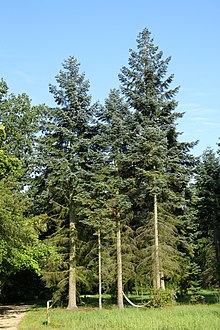Abies procera
| Abies procera | |
|---|---|

| |
| Scientific classification | |
| Kingdom: | Plantae |
| Clade: | Tracheophytes |
| Clade: | Gymnospermae |
| Division: | Pinophyta |
| Class: | Pinopsida |
| Order: | Pinales |
| Family: | Pinaceae |
| Genus: | Abies |
| Species: | A. procera
|
| Binomial name | |
| Abies procera | |

| |
| Natural range | |
| Synonyms[2] | |
| |
Abies procera, the noble fir, also called red fir and Christmas tree,
Description
A. procera is a large
The species can grow for up to 200 years.[5]
Taxonomy
David Douglas discovered the species in the Cascade Range in the early 19th century, calling it the "noble fir".[5]
The specific epithet procera means "tall".[6] It is the world's tallest true fir.[5]
Distribution
The species is native to the Cascade Range and Pacific Coast Ranges of western Washington and Oregon, as well as the extreme northwest of California. It is a high-altitude tree, typically occurring at altitudes of 300–1,500 m (980–4,920 ft), often above 600 m (2,000 ft),[5] and only rarely reaching the tree line.
Ecology
The species is very closely related to
Noble fir occurs with
Uses
The Paiute used the foliage to treat coughs and colds.[5]
The superior light and strong
David Douglas sent noble fir seeds to Britain in 1830, introducing it to horticulturalists.[5] It is a popular and favored Christmas tree.[5] The prostrate grey cultivar A. procera (Glauca Group) 'Glauca Prostrata' has gained the Royal Horticultural Society's Award of Garden Merit.[7][8]
-
Cone
-
Cones
-
Foliage
References
- . Retrieved 12 November 2021.
- ^ "The Plant List: A Working List of all Plant Species".
- ^ "Abies procera". Germplasm Resources Information Network. Agricultural Research Service, United States Department of Agriculture. Retrieved 17 December 2017.
- ^ "Gymnosperm Database - Abies procera". Retrieved 2013-09-06.
- ^ OCLC 1141235469.
- ISBN 978-1845337315.
- ^ "Abies procera (Glauca Group) 'Glauca Prostrata'". RHS. Retrieved 14 August 2019.
- ^ "AGM Plants - Ornamental" (PDF). Royal Horticultural Society. July 2017. p. 1. Retrieved 14 August 2019.
Further reading
- Farjon, A. (2013). "Abies procera". . Retrieved 12 November 2021.
External links
- USDA Plants Profile for Abies procera (noble fir)
- Interactive Distribution Map of Abies procera
- Abies procera—Gymnosperm Database
- Jepson Manual Treatment: Abies procera
- photos of Abies procera trees—Arboretum de Villardebelle
- photos of foliage and cones—Arboretum de Villardebelle
- Abies procera—U.C. Photo gallery




